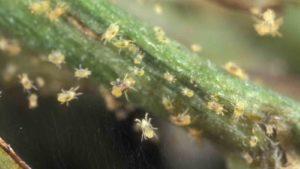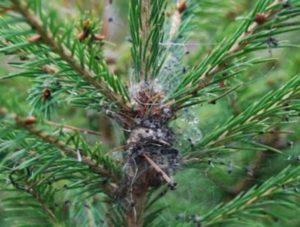Pests of coniferous trees: 13 insects that are not afraid of thorns
Coniferous forests have a beneficial effect on the human nervous system. Walking among such plants improves the functioning of the bronchi and lungs. However, pests can reduce the number of useful trees. They feed on needles and suck out the juice.
Content
Pests of conifers
Diseases of coniferous plants significantly spoil their appearance. Therefore, they need to be checked regularly. Often insects move from such plantings to other plants in the garden. Inspection and prevention is the key to the health of the entire garden.
Sawflies
Of the methods of struggle, there are:
- pheromone traps;
- adhesive belts;
- biological pesticides;
- insecticides.
spider mites
Parasites can be seen when there is morning dew on the trees. They weave a thin cobweb on young shoots. The size of the tick varies from 0,3 to 0,5 mm. The pest sucks the juice. As a result, the needles become brown.
An insect can develop in 8 generations. This usually occurs during the dry, hot summer months. The tick provokes premature fall of the needles. The wintering place is under the scale of the bark.
Pine bugs
The color is yellowish brown or reddish brown. Insects are similar to pine bark. Size from 3 to 5 mm. Wintering place - litter or exfoliated bark. In the spring, they get out and begin to suck out pine sap.
aphid
This insect poses the greatest threat to spruce. The sucking pest has a size of 1 to 2 mm. Thanks to the green coloring, it is perfectly camouflaged. The invasion of aphids contributes to yellowing and falling of the needles.
Hermes or mealybug
Visually, the insect resembles aphids. The body is oval. The color is yellowish with densely covered white discharge. They form a sticky white "cotton".
Winged spruce-fir hermes bends the needles and causes yellowing. Adult females live on the buds, yellowish-green or brown larvae on the needles. The place of wintering of adult larvae is the bark of branches, trunk, cracks. In winter, most of them die. In the spring, the population is insignificant. Increases in summer.
The most dangerous representatives include juniper and deciduous varieties.
Shchitovka
The pest is an enemy of thuja and junipers. Spruce suffers much less often. An insect appears in the middle of the crown. A small, shiny, brown pest colonizes on the bases of the shoots. The needles turn brown and fall off.
In addition to rounded females, there are males. Their size ranges from 1 to 1,5 mm. Because of their activity, the bark dies, the shoots dry out and bend, annual growth decreases. Often settle on yew and cypress.
sprouts
The pine species is a small butterfly. Caterpillars are pests. They destroy the kidneys. Resin needles appear at the tips of the shoots.
Resin shooter bites into the bark and forms resinous galls. The galls increase in size. The shoots above begin to dry out and bend.
Cone pests
You can determine the appearance of pests in cones by their visual state. They look eaten, dust is pouring in, they fall very quickly and ahead of time. Often, some types of pests coexist with others and damage the entire tree and garden.
The pest lays eggs in young cones under the scales.
The pest lives on young annual cones and shoots.
Lives on Siberian fir, lays eggs in cones and winters there.
The cone leafworm lives and feeds in cones, they love spruces.
preventive measures
A few tips to prevent pests:
- when planting choose sunny places;
- fertilize the soil with Kalimagnesia, Magnesium Sulphate, Magbor;
- water and mulch tree trunks with peat or coniferous sawdust;
- digging the ground under the trees and raking out the fallen needles is not recommended;
- wash the needles in the summer.
In pest control, it is appropriate to use Spark, Double Effect, Golden Spark, Senpai, Alatar, Fufafon, Spark-M. Treated with drugs only in the spring. The interval between treatments is 12 days.
Conclusion
Pests can disrupt the development of plants. The needles turn yellow and crumble, which leads to a decrease in the number of trees. At the first appearance of parasites, they are treated with the above compounds.
Previous



